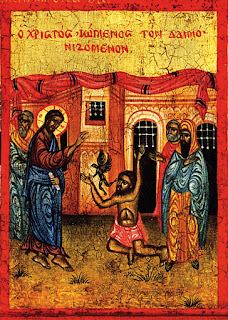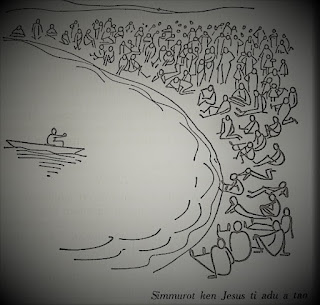The First Working Day of Jesus: Notes on Mark 1:21-45
 |
| Credit: hopelutheranchapel.org |
Literary Design
Against Klein, we can say also that for Mark, time and place are more theological than chronological (cf. “on the third day”) than geographical (cf. theological geography).
 |
Textual Observations
Philological Notes
v. 21 Synagogue. from the Gk. SYNAGEIN “to gather together” – a meeting place of Jews for worship, Torah study, and other religious functions; but not a usual place for prayer in NT.
v. 22 Scribes. Gk. GRAMMATEUS – men trained in the copying of manuscripts; “secretary”— that they are “experts” of the Law may be due to the fact that they copy the Torah for reproduction. In the time of Jesus, they did not consist a homogenous religious group with a distinct power (Meier, Marginal Jew III: 560. In fact, here in Mark, it is clear that they do not have the “authority.” Jesus Ben Sira (author of Sirach) was a respected scribe because he was also a SOPHOS (Heb. HAKAM), “sage.”
v. 23 Unclean Spirit. Gk. PNEUMATI AKATHARTŌ, a Jewish term for a demon; invisible, Usupernatural being causing havoc in human life. They are “unclean” in contradistinction to the ritually clean person in the Old Testament.
v. 28 fame. Gk. AKOĒ, lit. “ear,” thus “hearing, report, rumor” also “fame” but in a positive way “preaching” (cf. 1 Thes 2:13)
v. 35 In the morning [PRŌI], while still dark. PRŌI means “early,” from 3:00 to 6:00 A.M.
v. 35 prayed. Gk. PROSEUCHOMA = PROS+EUCHOMAI, “towards, change”+ “wish, pray” thus literally “to exchange wishes” or “to interact with.” Jews prayed ad alta voce.
v. 36 hunted for. Gk. KATEDIŌXEN. The root is “to pursue, persecute”. The word is used for hunting down enemies.
v. 40. Leper. Gk. LEPROS, not necessarily Hansen’s disease (discovered in1873) but designates a variety of conditions involving scaly skin (cf. Leviticus 13-14). It develops quickly, and people sometimes recover from it. “A man suffering from a virulent skin-disease” (NJB). One afflicted with this is a “living dead” whose healing was equivalent to being raised from the dead (cf. 2 Kgs 5:7).
--as we have seen earlier, there are
three episodes here as Jesus begins his very first day of work:
·
Teaching with authority (EXOUSIA)
and exorcism on a Sabbath at the
Synagogue
·
Report about Jesus spreading abroad (around the
region of Galilee)
·
Healing of the mother-in-law of Peter.
Literary Commentary
First Stage: In Capernaum on the Sabbath (1:21-31)
Episode 1: Jesus Teacheas with Authority
---scholars usually categorize the genre of “miracle” ( a word not used in the NT) into four types: exorcism, healing, nature miracle, restoration. N.B. no exorcism in John.
--Most of Mark’s miracles are the exorcism type (7 out of 18 miracle episodes; 8 as sammelberichte (the German word for "summary report"); or 15 incidents all in all ].
-- an exorcism episode in the Synoptics follows a distinctive
pattern:
1)
personal encounter between Jesus and the
possessed person (1:23)
2)
the demons defend themselves (1:24)
3)
Jesus’ command to be quiet (1:25)
4)
Demons are cast out (1:26)
5)
people are amazed. (1:27)
--even a simple “fever” like the one Peter’s mother-in-law had, you needed an exorcist (in Luke 4:39 Jesus “rebuked” the Fever).
Episode 2: Report about Jesus
Episode 3: The Healing of the Mother-in-law of Peter.
--Mark presents a female counterpart of the earlier exorcism of a man:
.. note that the man with an unclean spirit was healed in the synagogue (a public place); while Peter’s mother-in-law was healed inside the house (private sphere of women).
-- That Jesus was informed of her illness “immediately” [another EUTHUS] indicates her indispensable role in the household (= matriarch?)
.. Contrast Naaman’s remark in 2 Kings 5:11 (not touching but laying on hand)
--v. 31b “she began to serve them” The verb in Greek is DIAKONEO in the Imperfect Tense: DIĒKONEI :
.. Same verb for the ideal of leadership/discipleship as the humble service to others (see
10:45)
… Note that the verb is in the imperfect tense: she kept on serving them, meaning, service was not done only once.
The Second Stage: In Galilee, the Day after the Sabbath (vv. 35-45)
--the second stage also consists of three episodes:
·
Jesus’ prayer
moment
·
Jesus’ going “abroad” preaching (KERUSSON)
throughout Galilee
·
Jesus heals a
leper.
--v. 35 notice that Jesus begins his “day” with prayer. Mark does not inform us what Jesus prayed (cf. short prayer at Gethsemane in 14:36). But Mark again uses here the imperfect tense PROSĒUCHETO – lit. he was praying; kept praying—in the sense of habitual act.
Daily prayer is done early in the morning as part of Jewish piety. God listens to morning prayers (cf. Psa 5:3; etc). Jesus also prayed at the end of the day (6:46); and at night at Gethsemane in 14:32-42. Jesus urges his disciples to pray in 9:29; 11:24-25; and 13:18. But he criticizes long prayers of scribes when used as a pretext for the exploitation of widows (12:40).
The Episode on the Healing of the Leper
--v. 40. The leper was candid and says: If you choose, you can make me clean. The Greek, however, reads: “If you will, you have the power [DYNAMAI] to make me clean” (Donahue and
Harrington, underline for
emphasis). The use of DYNAMIS here connects Jesus as the Stronger One and one
who embodies new teaching and power (cf. 1:27-28).
--v. 41 “Deeply moved with compassion”(v. 41):
..This is a much-debated phrase among biblical scholars. Other Greek manuscripts have “moved with anger”.. The two readings are possible. In two other healing stories (Mk 6:34; 8:2) and curing the possessed boy (9:22), Jesus acts with compassion. Jesus healed out of compassion. It reflects the presence of the kingdom of God where mercy and compassion rule.
.. “Moved with anger” can also be a possible translation. Jesus’ anger is a “righteous anger” that is directed to the distortion of God’ creature by the forces of evil (Guelich, Mark 1989).
..v. 41 Jesus touched the leper. (v. 41). Note how Mark was emphatic about this gesture: Jesus first stretched out his and then touched him.
.. Did Jesus violate laws o purity rules of his own religion?
--by touching the unclean man, Jesus in NO way rejected the purity laws; rather, he restores the man to a clean state, leaving the purity rules INTACT. Note that the pericope mentions the word “clean” four times and the two are on Jesus' lips! Likewise, Jesus requires the man to present the offering prescribed by law (v. 44). [For this, see The Jewish Annotated New Testament, 62.
-- v. 44. See that you say nothing to anyone. Again Markan motif, “Messianic Secret”
.. Messianic Secret is a term among the biblical scholars for the passages where Jesus forbade his followers to reveal who he is. Scholars explain this in different ways:
(3) From a cultural point of view, secrecy is a cultural practice in the time of Jesus. It is an important element in gaining and maintaining one’s honor (honor being a core cultural value among the Mediterranean people). Secrecy is the selective transmission of information. Jesus practiced secrecy to safeguard his ascribed honor, otherwise, Jesus’ shameful fate (death via crucifixion) would have been potentially damaging information about himself (see Pilch, 1999:12ff.).
--v. 45 The leper is told to show
himself to the priest. In the book of Leviticus (13:47-14:54), the priest has
to declare that a leper has been cured, or that he is now “clean”. But Mr.
Leper “disobeyed”. He went around preaching (KERUSSON). He was the one who
violated Jesus’ command to say nothing to anyone.
--Mark’s conclusion is filled with ironies:
- the leper who was not allowed to appear in public now goes everywhere
- Jesus who went out in public is the one who cannot appear openly
- Jesus’ ability to heal is now the cause of his inability to move about.
--From the conclusion, we see Mark’s purpose is the proclamation (KERYSSON/KERYMA) of the GOOD NEWS (about Jesus and Jesus himself). Why in the first place did Jesus enter the Synagogue on the very first day of his work? To teach and to preach!
Thus, Mark, the Gospel writer, is ready to break his own literary rules and conventions to accomplish this purpose.
And so for instance, when Jesus is informed that everyone is searching for him, Mark makes Jesus move again to another place: “Let us go on to the neighboring town, so that I may proclaim the message there also; for that is what I came out to do” (v. 38).
Theological Commentary
Mark narrates the first “Day” of Jesus, his first “working day,” as a ministry full of powerful activity.


Salamatng marami nito Fr Randy. Para ito sa amin na walang formal education on the the bible, etc..... for sure makakadagdag ito sa aking kaalaman, and will subsequently equip me to my dream of being a faith defender.
ReplyDeleteThis is a good follow-up to Fr. Jojie Padilla's Kwentong Biblia recent session - How to read the Gospel of Mark. Thanks.
ReplyDelete